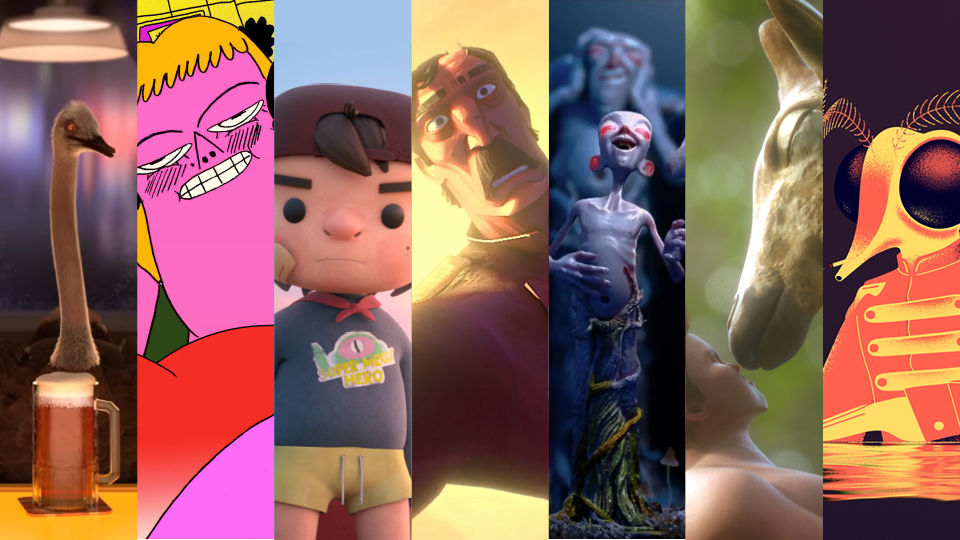
The creative challenge and promise of the self-imposed brief make the short film a treasured opportunity for both professionals taking a break from client work and students trying to launch careers with the perfect graduation project.
All these films were published in The Stash Permanent Collection during 2019 and appear here in chronological order by the date of publication.
“THE OSTRICH POLITIC”
STASH 133
Mohamad HouHou, director in Paris: “The project was a final year short graduation film produced at Gobelins. There weren’t any specific instructions other than using an animation medium.
“On the creative end, writing the script/poem was very challenging. I worked on finding a balance between the narration and the visuals, to help them assist each other.
“Any additional word on certain lines might have delayed the audience comprehension and distracted them from understanding the story.”
“JACOB AND THE GIRAFFE”
STASH 136
Brian Tessler, director and co-founder at Cool 3D World in Brooklyn: “Although we often do client work, this was one of our animated short films which we upload to our social media channels.
“We tried to tell a more straightforward story with this one, which was a different type of challenge for us – many of our videos are more abstract/experimental. This project also featured a large amount of motion capture – more than any other of our previous videos.”
“HOT AND TASTY”
STASH 137
Director Laura Jayne Hodkin in London: “‘Hot and Tasty’ is my graduation film made at the Royal College of Art.
“Before writing anything, I recorded me and my friend getting drunk together and talking shit to get a feel for what I wanted it to sound like. When I finally recorded with my voice actors I didn’t want them to rely on the script that much, so improvisation came into play too.
“I didn’t really appreciate how much time it would take to animate a scene on paper, shoot the scene and then color and composite everything digitally, so I made the switch to digital animation. Most of the scenes I did on paper were still used in the final film, so it didn’t totally go to waste.”
“THE STAINED CLUB”
STASH 137
Co-director Melanie Lopez in Paris: “The idea for our student film was to tell the story of a kid who would have his emotional pain marked on his body, so everyone could see it.
“The main challenge was to make people understand what the meaning of the stains was without saying too much so the audience could make their own interpretation of it.”
“THE BOX”
STASH 137
Slovenian animator/illustrator Dušan Kastelic combines imagery from his own recurring nightmare with a story he’d penned for a comic book years earlier to create a 3D animated mini-masterpiece (and massive festival hit) called “The Box.”
“One night I had a nightmare; I was in a very dark place in the middle of a large crowd of people. I noticed they couldn’t move because they had roots instead of legs growing into the ground. I desperately tried to wake them up and tell them something. All of a sudden they opened their eyes and started yelling. Then I woke up, all sweaty.
“I just couldn’t get those images out of my head and I decided that I would deal with them by using them in an animated film.”
“INTO THE FLAME”
STASH 138
Cloie Leger, Associate Producer at Hue&Cry in Richmond, VA: “Since this was an internal project we didn’t have a traditional brief, just some themes we wanted to explore.
“Originally the project was intended to be a brief poetic statement, no more than 30 seconds in length. But as the story developed we saw there was something bigger that wanted to come out.
“Early in the writing process, two potential storylines emerged and the director Sean McClintock wanted to see if it would be possible to leave the door open enough to allow the viewer to decide which transpired.”
“YONA”
STASH 138
Co-directors Kevin Rose and Gautier Alfirevic in Arcueil, France: “The film began with a picture of a skin-walker (a legendary harmful witch of the Navajo culture) we found on the internet.
“The most difficult part of our storytelling process was to talk about introspection in such a short running time as building a character going through self-questioning takes time and we wanted a character the audience could connect with and accept his transformation.
“The main challenge was to use what both 3D and 2D techniques had to offer to come up with visuals that we were happy with. We wanted to keep a handcrafted feel and break the clean aesthetic that often comes with 3D.”
